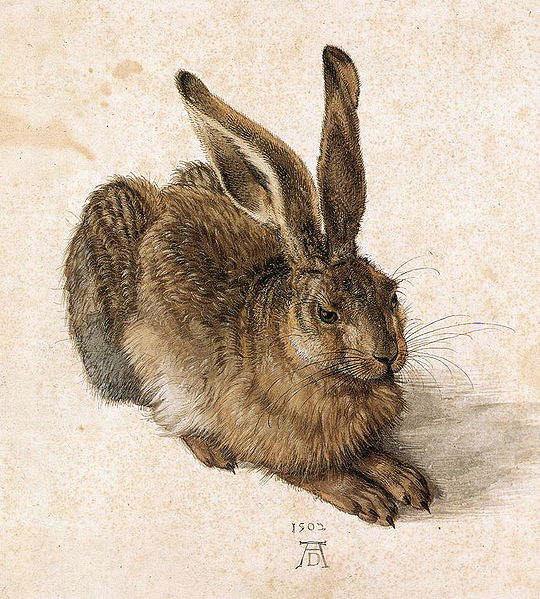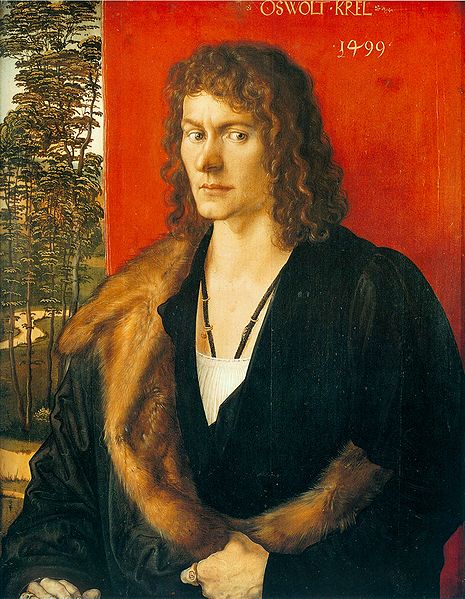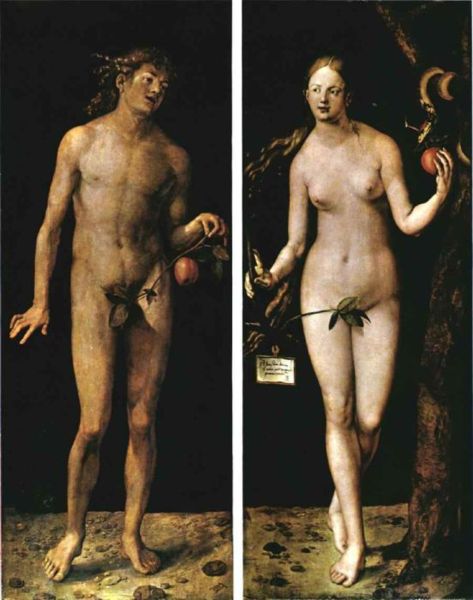<Back to Index>
- Physicist Andrei Dimitrievich Sakharov, 1921
- Painter Albrecht Dürer, 1471
- King of Spain Philip II, 1527
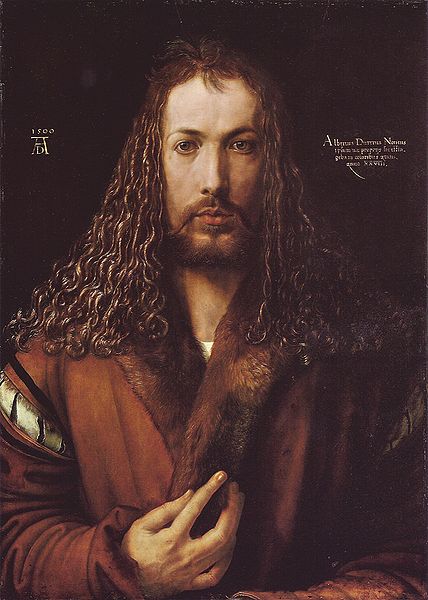
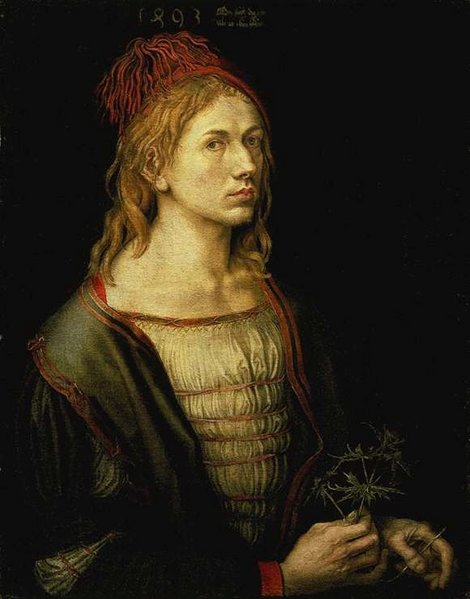
Albrecht Dürer (21 May 1471 – 6 April 1528) was a German painter, printmaker and theorist from Nuremberg.
His prints established his reputation across Europe when he was still
in his twenties, and he has been conventionally regarded as the
greatest artist of the Northern Renaissance ever since. His well-known works include the Apocalypse woodcuts, Knight, Death, and the Devil (1513), Saint Jerome in his Study (1514) and Melencolia I (1514), which has been the subject of extensive analysis and interpretation. His watercolours mark him as one of the first European landscape artists, while his ambitious woodcuts revolutionized the potential of that medium. Dürer's introduction of classical motifs into Northern art, through his knowledge of Italian artists and German humanists, have secured his reputation as one of the most important figures of the Northern Renaissance. This is reinforced by his theoretical treatise which involve principles of mathematics, perspective and ideal proportions. Dürer
was born on 21 May 1471, third child and second son of his parents, who
had between fourteen and eighteen children. His father was a successful goldsmith, originally named Ajtósi, who in 1455 had moved to Nuremberg from Ajtós, near Gyula in Hungary. The German name "Dürer" is derived from the Hungarian,
"Ajtósi". Initially, it was "Thürer," meaning doormaker,
which is "ajtós" in Hungarian (from "ajtó", meaning
door). A door is featured in the coat-of-arms the
family acquired. Albrecht Dürer the Elder married Barbara Holper,
the daughter of his master, when he himself became a master in 1467. Dürer's godfather was Anton Koberger, who left goldsmithing to become a printer and publisher in the year of
Dürer's birth. He quickly became the most successful publisher in
Germany, eventually owning twenty-four printing-presses and having many offices in Germany and abroad. His most famous publication was the Nuremberg Chronicle, published in 1493 in German and Latin editions. It contained an unprecedented 1,809 woodcut illustrations (with many repeated uses of the same block) by the Wolgemut workshop. Dürer may well have worked on some of these, as the work on the project began while he was with Wolgemut. It
is fortunate Dürer left autobiographical writings and that he
became very famous by his mid-twenties. Because of this, his life is
well documented by several sources. After a few years of school,
Dürer started to learn the basics of goldsmithing and drawing from
his father. Though his father wanted him to continue his training as a
goldsmith, he showed such a precocious talent in drawing that he
started as an apprentice to Michael Wolgemut at the age of fifteen in 1486. A self-portrait, a drawing in silverpoint, is dated 1484 (Albertina, Vienna)
“when I was a child”, as his later inscription says. Wolgemut was the
leading artist in Nuremberg at the time, with a large workshop
producing a variety of works of art, in particular woodcuts for books.
Nuremberg was then an important and prosperous city, a centre for
publishing and many luxury trades. It had strong links with Italy, especially Venice, a relatively short distance across the Alps. After completing his term of apprenticeship, Dürer followed the common German custom of taking Wanderjahre — in effect gap years —
in which the apprentice learned skills from artists in other areas;
Dürer was to spend about four years away. He left in 1490,
possibly to work under Martin Schongauer, the leading engraver of Northern Europe, but who died shortly before Dürer's arrival at Colmar in 1492. It is unclear where Dürer travelled in the intervening period, though it is likely that he went to Frankfurt and the Netherlands. In Colmar, Dürer was welcomed by Schongauer's brothers, the
goldsmiths Caspar and Paul and the painter Ludwig. In 1493 Dürer
went to Strassbourg, where he would have experienced the sculpture of Nikolaus Gerhaert. Dürer's first painted self-portrait (now in the Louvre) was painted at this time, probably to be sent back to his fiancé in Nuremberg. In early 1492 Dürer travelled to Basel to stay with another brother of Martin Schongauer, the goldsmith Georg. Very
soon after his return to Nuremberg, on 7 July 1494, at the age of 23,
Dürer was married to Agnes Frey following an arrangement made
during his absence. Agnes was the daughter of a prominent brass worker
(and amateur harpist) in the city. However, no children resulted from
the marriage. Within three months Dürer left for Italy, alone, perhaps stimulated by an outbreak of plague in Nuremberg. He made watercolour sketches as he traveled over the Alps. Some have survived and others may be
deduced from accurate landscapes of real places in his later work, for
example his engraving Nemesis. These are the first pure landscape studies known in Western art. In Italy, he went to Venice to study its more advanced artistic world. Through Wolgemut's tutelage, Dürer had learned how to make prints in drypoint and design woodcuts in the German style, based on the works of Martin Schongauer and the Housebook Master. He
also would have had access to some Italian works in Germany, but the
two visits he made to Italy had an enormous influence on him. He wrote
that Giovanni Bellini was the oldest and still the best of the artists in Venice. His drawings and engravings show the influence of others, notably Antonio Pollaiuolo with his interest in the proportions of the body, Mantegna, Lorenzo di Credi and others. Dürer probably also visited Padua and Mantua on this trip. On
his return to Nuremberg in 1495, Dürer opened his own workshop
(being married was a requirement for this). Over the next five years
his style increasingly integrated Italian influences into underlying
Northern forms. Dürer lost both of his parents during the next
decade: his father died in 1502 and his mother died in 1513. His best works in the first years of the workshop were his woodcut prints, mostly religious, but including secular scenes such as The Men's Bath House (ca.
1496). These were larger than the great majority of German woodcuts
hitherto, and far more complex and balanced in composition. It
is now thought unlikely that Dürer cut any of the woodblocks
himself; this task would have been performed by a specialist craftsman.
However, his training in Wolgemut's studio, which made many carved and
painted altarpieces and both designed and cut woodblocks for woodcut,
evidently gave him great understanding of what the technique could be
made to produce, and how to work with block cutters. Dürer either
drew his design directly onto the woodblock itself, or glued a paper
drawing to the block. Either way, his drawings were destroyed during
the cutting of the block. His famous series of sixteen great designs for the Apocalypse are dated 1498. He made the first seven scenes of the Great Passion in the same year, and a little later, a series of eleven on the Holy Family and saints. Around 1503–1505 he produced the first seventeen of a set illustrating the Life of the Virgin, which he did not finish for some years. Neither these, nor the Great Passion, were published as sets until several years later, but prints were sold individually in considerable numbers. During the same period Dürer trained himself in the difficult art of using the burin to make engravings.
It is possible he had begun learning this skill during his early
training with his father, as it was also an essential skill of the
goldsmith. The first few were relatively unambitious, but by 1496 he
was able to produce the masterpiece, the Prodigal Son, which Vasari singled
out for praise some decades later, noting its Germanic quality. He was
soon producing some spectacular and original images, notably Nemesis (1502), The Sea Monster (1498), and Saint Eustace (ca.1501), with a highly detailed landscape background and beautiful animals. He made a number of Madonnas,
single religious figures, and small scenes with comic peasant figures.
Prints are highly portable and these works made Dürer famous
throughout the main artistic centres of Europe within a very few years. The Venetian artist Jacopo de' Barbari, whom Dürer had met in Venice, visited Nuremberg in 1500, and
Dürer said that he learned much about the new developments in perspective, anatomy, and proportion from
him. He was unwilling to explain everything he knew, so Dürer
began his own studies, which would become a lifelong preoccupation. A
series of extant drawings show Dürer's experiments in human
proportion, leading to the famous engraving of Adam and Eve (1504), which shows his subtlety while using the burin in the texturing of flesh surfaces. This is the only existing engraving signed with his full name. Dürer
made large numbers of preparatory drawings, especially for his
paintings and engravings, and many survive, most famously the Praying Hands (1508 Albertina, Vienna), a study for an apostle in the Heller altarpiece. He also continued to make images in watercolour and bodycolour (usually combined), including a number of exquisite still lifes of meadow sections or animals, including his "Hare" (1502) and the Great Piece of Turf (1503, both also Albertina).
In Italy, he returned to painting, at first producing a series of works executed in tempera on linen. These include portraits and altarpieces, notably, the Paumgartner altarpiece and the Adoration of the Magi. In early 1506, he returned to Venice and stayed there until the spring of 1507. By
this time Dürer's engravings had attained great popularity and
were being copied. In Venice he was given a valuable commission from
the emigrant German community for the church of San Bartolomeo. This was the altar-piece known as the Adoration of the Virgin or the Feast of Rose Garlands.
It includes portraits of members of Venice's German community, but
shows a strong Italian influence. It was subsequently acquired by the
Emperor Rudolf II and taken to Prague. Other paintings Dürer produced in Venice include The Virgin and Child with the Goldfinch, Christ disputing with the Doctors (supposedly produced in a mere five days), and a number of smaller works.
Despite
the regard in which he was held by the Venetians, Dürer was back
in Nuremberg by mid-1507, and he remained in Germany until 1520. His
reputation had spread throughout Europe and he was on friendly terms
and in communication with most of the major artists including Raphael, Giovanni Bellini and—mainly through Lorenzo di Credi—Leonardo. Between 1507 and 1511 Dürer worked on some of his most celebrated paintings: Adam and Eve (1507), The Martyrdom of the Ten Thousand (1508, for Frederick the Wise), Virgin with the Iris (1508), the altarpiece Assumption of the Virgin (1509, for Jacob Heller of Frankfurt), and Adoration of the Trinity (1511, for Matthaeus Landauer). During this period he also completed two
woodcut series, the Great Passion and the Life of the Virgin, both
published in 1511 together with a second edition of the Apocalypse
series. The post-Venetian woodcuts show Dürer's development of chiaroscuro modelling effects, creating a mid-tone throughout the print to which the highlights and shadows can be contrasted. Other
works from this period include the thirty-seven woodcut subjects of the
Little Passion, published first in 1511, and a set of fifteen small
engravings on the same theme in 1512. Indeed, complaining that painting
did not make enough money to justify the time spent when compared to
his prints, he produced no paintings from 1513 to 1516. However, in
1513 and 1514 Dürer created his three most famous engravings: The Knight, Death, and the Devil (1513, probably based on Erasmus's treatise 'Enichiridion militis Christiani'), St. Jerome in his Study, and the much-debated Melencolia I (both 1514). In 1515, he created his woodcut of the Rhinoceros which had arrived in Lisbon from
a written description and sketch by another artist, without ever seeing
the animal himself. Despite being a relatively inaccurate image of the Indian rhinoceros,
the image has such force that it remains one of his best-known and was
still used in some German school science text-books as late as last
century. In the years leading to 1520 he produced a wide range of works, including portraits in tempera on linen in 1516. From 1512, Maximilian I, became Dürer's major patron. His commissions included The Triumphal Arch, a vast work printed from 192 separate blocks, the symbolism of which is partly informed by Pirckheimer's translation of Horapollo's Hieroglyphica. The design program and explanations were devised by Johannes Stabius,
the archtectural design by the master builder and court-painter
Jörg Kölderer and the woodcutting itself by Hieronymous
Andreae, with Dürer as designer-in-chief. The Arch was followed by
the Triumphal Procession, the program of which was worked out in 1512 by Marx Treitz-Saurwein and includes woodcuts by Albrecht Altdorfer and Hans Springinklee, as well as Dürer. Dürer
worked in pen on the marginal images for an edition of the Emperor's
printed Prayer-Book; these were quite unknown until facsimiles were
published in 1808 as part of the first book published in lithography. Dürer's work on the book was halted for an unknown reason, and the decoration was continued by artists including Lucas Cranach the Elder and Hans Baldung. Dürer also made several portraits of the Emperor, including one shortly before Maximilian's death in 1519. Maximilian's sudden death came at a time when Dürer was concerned he was losing "my sight and freedom of hand" (perhaps to arthritis) and increasingly affected by the writings of Martin Luther. In
July 1520 Dürer made his fourth and last major journey, to renew
the Imperial pension Maximilian had given him and to secure the
patronage of the new emperor, Charles V, who was to be crowned at Aachen. Dürer journeyed with his wife and her maid via the Rhine to Cologne and then to Antwerp, where he was well-received and produced numerous drawings in silverpoint, chalk and charcoal. In addition to going to the coronation, he made excursions to Cologne (where he admired the painting of Stefan Lochner), Nijmegen, 's-Hertogenbosch, Bruges (where he saw Michelangelo's Madonna of Bruges), Ghent (where he admired van Eyck's altarpiece), and Zeeland. Dürer
took a large stock of prints with him and wrote in his diary to whom he
gave, exchanged or sold them, and for how much. This provides rare
information of the monetary value placed on prints at this time. Unlike paintings, their sale was very rarely documented. While
providing valuable documentary evidence, Dürer's Netherlandish
diary also reveals that the trip was not a profitable one. For example,
Dürer offered his last portrait of Maximilian to his daughter, Margaret of Austria,
but eventually traded the picture for some white cloth after Margaret
disliked the portrait and declined to accept it. During this trip he
also met Conrad Meit, Bernard van Orley, Jean Prevost, Gerard Horenbout, Jean Mone, Joachim Patinir & Tommaso Vincidor, though he did not, it seems, meet Quentin Matsys. At the request of Christian II of Denmark Dürer went to Brussels to paint the King's portrait. There he saw "the things which have been sent to the king from the golden land" — the Aztec treasure that Hernán Cortés had sent home to Holy Roman Emperor Charles V following the fall of Mexico.
Dürer wrote that this treasure "was much more beautiful to me than
miracles. These things are so precious that they have been valued at
100,000 florins". Dürer also appears to have been collecting for his own cabinet of curiosities, and he sent back to Nuremberg various animal horns, a piece of coral, some large fish fins, and a wooden weapon from the East Indies. Having secured his pension, Dürer finally returned home in July 1521, having caught an undetermined illness — perhaps malaria — which afflicted him for the rest of his life, and greatly reduced his rate of work. On his return to Nuremberg, Dürer worked on a number of grand projects with religious themes, including a Crucifixion scene and a Sacra Conversazione, though neither was completed. This
may have been in part to his declining health, but perhaps also because
of the time he gave to the preparation of his theoretical works on geometry and perspective, the proportions of men and horses, and fortification. However,
one consequence of this shift in emphasis was that during the last
years of his life, Dürer produced comparatively little as an
artist. In painting, there was only a portrait of Hieronymus Holtzschuher, a Madonna and Child (1526), Salvator Mundi (1526), and two panels showing St. John with St. Peter in front and St. Paul with St. Mark in the background. This last great work, the Four Apostles, was given by Dürer to the City of Nuremberg — although he was given 100 guilders in return. An inscription relates the figures to the four humours. As
for engravings, Dürer's work was restricted to portraits and
illustrations for his treatise. The portraits include Cardinal-Elector Albert of Mainz; Frederick the Wise, elector of Saxony; the humanist scholar Willibald Pirckheimer; Philipp Melanchthon, and Erasmus of Rotterdam. For those of the Cardinal,
Melanchthon, and Dürer's final major work, a drawn portrait of the
Nuremberg patrician Ulrich Starck, Dürer depicted the sitters in
profile, perhaps reflecting a more mathematical approach. Despite complaining of his lack of a formal classical education Dürer was greatly interested in intellectual matters and learned much from his boyhood friend Willibald Pirckheimer,
whom he no doubt consulted on the content of many of his images. He
also derived great satisfaction from his friendships and correspondence
with Erasmus and other scholars. Dürer succeeded in producing two
books during his lifetime. "The Four Books on Measurement" were
published at Nuremberg in 1525 and was the first book for adults on mathematics in German, as well as being cited later by Galileo and Kepler.
The other, a work on city fortifications, was published in 1527. "The
Four Books on Human Proportion" were published posthumously, shortly
after his death in 1528 at the age of fifty-six. Dürer
died in Nuremberg at the age of 56, leaving an estate valued at 6,874
florins—a considerable sum. His large house (purchased in 1509 from the
heirs of the astronomer Bernhard Walther), where his workshop was located and where his widow lived until her death in 1539, remains a prominent Nuremberg landmark. It is now a museum. He is buried in the Johannisfriedhof cemetery.
